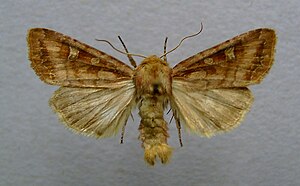Wet meadow herb owl
| Wet meadow herb owl | ||||||||||||
|---|---|---|---|---|---|---|---|---|---|---|---|---|

Wet meadow herb owl ( Lacanobia (Diataraxia) splendens ) |
||||||||||||
| Systematics | ||||||||||||
|
||||||||||||
| Scientific name | ||||||||||||
| Lacanobia (Diataraxia) splendens | ||||||||||||
| ( Huebner , 1808) |
The wet meadow herb owl ( Lacanobia (Diataraxia) splendens ), also known as the red bog owl, is a butterfly ( moth ) from the owl butterfly family (Noctuidae).
features
The wingspan of the moth is 32 to 39 millimeters. The basic color of the forewings varies from bright reddish brown to dark reddish brown. Cones, kidney and ring blemishes stand out clearly and are tinted yellow-gray or light brown. The fields next to and below the kidney and ring blemishes are more intensely colored. The fringing area is lightened, the wavy line is mostly thin and indistinct, as is the W symbol, which is far from the hem. The hind wings show a light gray-brown color.
The egg is hemispherical with a flattened base. It's yellow with a darker central zone. The surface has strong longitudinal ribs.
The caterpillars, which are mostly brown, are unmistakable due to the striking, wide, light yellow and upwardly finely black bordered side line .
Similar species
The species resembles the reddish forms of the vegetable owl ( Lacanobia oleracea ), but can be recognized by the more yellowish kidney defects and the clearer W-sign that extends to the edge.
Geographical distribution and habitat
The species is widespread in the temperate climates of Europe and Asia to the Pacific coast and Japan. E. & H. Urbahn describe them as an animal of the moors, swamp meadows and floodplains.
Way of life
The wet meadow herb owl usually forms two generations per year, whereby the second generation is only partial. The moths of the first generation fly from late May to mid-July, the moths of the second generation in August. The moths are predominantly crepuscular and nocturnal, but also suckle on various flowers during the day or at dusk, for example sage ( Salvia ). They come across artificial light sources , and occasionally also the bait . The caterpillars live from August to September. They feed on the leaves of water hemlock ( Cicuta virosa ), fever clover ( Menyanthes trifoliata ), and other lower plants. The species overwinters as a pupa.
Danger
The wet meadow herb owl is only found very locally in damp places in Germany and is usually found individually. It is listed in category 3 (endangered) on the red list of endangered species .
Systematics
The genus Lacanobia is described by Hacker et al. (2002) divided into three sub-genera. Lacanobia splendens is added to the subgenus Diataraxia Hübner, 1821.
swell
literature
- Günter Ebert (Ed.): The butterflies of Baden-Württemberg. Volume 7: Moths. V. Ulmer Verlag, Stuttgart 1998, ISBN 3-8001-3500-0 .
- Hermann Hacker, László Ronkay, Márton Hreblay: Noctuidae Europaeae. Volume 4: Hadeninae I. Entomological Press, Søro 2002, ISBN 87-89430-07-7 .
Individual evidence
- ↑ Red Lists
- ^ Hermann Hacker, László Ronkay, Márton Hreblay: Noctuidae Europaeae. Volume 4, Hadeninae I. Entomological Press, Søro 2002, ISBN 87-89430-07-7 .
- ↑ Walter Forster , Theodor A. Wohlfahrt : The butterflies of Central Europe. Volume 4: Owls. (Noctuidae). Franckh'sche Verlagshandlung, Stuttgart 1971, ISBN 3-440-03752-5 .
- ↑ a b Günter Ebert (Ed.): The butterflies of Baden-Württemberg. Volume 7: Nachtfalter V. Ulmer Verlag Stuttgart 1998, ISBN 3-8001-3500-0
- ↑ Manfred Koch : We identify butterflies. Volume 3: Owls. 2nd, expanded edition. Neumann, Leipzig / Radebeul 1972, DNB 760072930 .
- ↑ Federal Agency for Nature Conservation (Ed.): Red List of Endangered Animals in Germany. Landwirtschaftsverlag, Münster 1998, ISBN 3-89624-110-9 .
Web links
- webh01.ua.ac.be photo
- www.schmetterlinge-deutschlands.de Endangerment
- Lacanobia splendens in Fauna Europaea